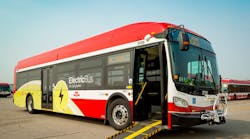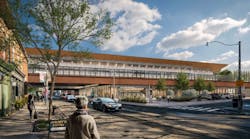The government of Ontario plans to extend the Hazel McCallion Light Rail Transit (LRT) by building the Mississauga loop and bringing the line into downtown Brampton.
“Our government is investing more than C$70 billion (US$52 billion) during the next decade to lead the largest expansion of public transit in North America, including across Peel and Milton regions,” said Ontario Premier Doug Ford. “Alongside Highway 413 and the Bradford Bypass, our government has a plan to move Peel and Milton regions’ people and economy forward.”
The LRT project will include a four-kilometer (2.5-mile) extension of the line into downtown Brampton via Main Street from the Brampton Gateway Terminal and a two-kilometer (1.2-mile) extension with a loop in Mississauga. The Mississauga loop was originally included in the Hurontario line project, now known as the Hazel McCallion Line, but removed from the project scope in 2019 as a cost control measure.
Mississauga has advocated to see the loop’s construction calling it “critical to the growth” of the downtown core. The loop will connect LRT service to Square One, with additional stops through to Confederation Parkway. The LRT will provide one of Canada’s quickest-growing cities with faster, more frequent and more reliable transit than the existing bus service, travelling in an exclusive right-of-way with signal priority at intersections. The LRT project includes approximately 20 kilometers (12.4 miles) of new rapid transit connecting with local and regional transit networks.
The government of Ontario is also calling on the government of Canada to agree to a cost-sharing partnership that will deliver all-day, two-way GO rail service along the Milton GO rail corridor by building a fully separated passenger rail line. The Milton GO rail corridor is the fourth busiest line on the GO network and serves as a vital transit connection between Milton, Mississauga and the rest of the Greater Golden Horseshoe. The government of Ontario is also planning to reinstate train trips, improve stations with new customer amenities such as expanding the south parking lot and a pedestrian bridge at Milton GO station and advance the planning and design work to support future two-way, all-day service. By 2031, the province will introduce a two-way, all-day GO train service every 15 minutes in key corridors across the Greater Golden Horseshoe. By 2041, the Milton corridor is expected to have up to 94,000 daily riders.
“Everyone in Ontario deserves access to reliable transit options that connect them to good-paying jobs and housing," said Prabmeet Sarkaria, Ontario’s minister of transportation. “The extension of the Hazel McCallion LRT and Milton GO rail corridor are essential next steps in our mission to get commuters where they need to go, when they need to be there. We urge the federal government to share in the cost of this critical project in Milton to meet the growing needs of this region.”
“All-day, two-way GO Train service on the Milton Line is a game changer for Mississauga. It has long been a top transit and city-building priority for our city,” said Mississauga Acting Mayor Joe Horneck. “For too long, the train has travelled the wrong way for Mississauga residents and businesses. Along with the federal commitment made two years ago, this project can finally move forward. It is our hope that the federal and provincial governments can work together to make this project a reality as soon as possible. On behalf of City Council, I want to thank the province for these investments in Mississauga.”
The government of Ontario will launch the One Fare program on Feb. 26. The program will enable transit riders using multiple transit agencies to transfer at no extra charge, helping them save an average of C$1,600 (US$1,188) each year.
The government of Ontario continues to expedite the planning, design and construction of its five priority transit projects under the Building Transit Faster Act, 2020, which includes the Ontario Line, the Scarborough Subway Extension, the Eglinton Crosstown West Extension, the Yonge North Subway Extension and Hamilton Light Rail Transit project.







